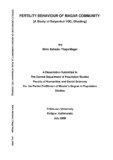Please use this identifier to cite or link to this item:
https://elibrary.tucl.edu.np/handle/123456789/3474| Title: | Fertility Behaviour of Magar CommuniTY [A Study of Salyankot VDC, Dhading] |
| Authors: | Magar, Bhim Bahadur Thapa |
| Keywords: | Fertility;Household Population |
| Issue Date: | 2009 |
| Publisher: | Department of Population Studies |
| Institute Name: | Central Department of Population Studies |
| Level: | Masters |
| Abstract: | This Study deals with “Fertility behavior of Magar Community: AStudy of Salyankot VDC, Dhading”. To complete this Study primary andsecondary data are collected. The analysis and interpretation of data arecarried out by frequency and cross tabulation. This Study is mainly based on the consideration that fertility isdetermined by different socio-economic and demographic variables. Only135 respondents of Magar community in Salyankot VDC are taken toexamine the relation of fertility with socio-economic and somedemographic variables. The specific objectives of this analysis are socio-economic anddemographic characteristics of ever married women of aged (15-49) toaccess the relationship between fertility and specific socio-economicvariables as education, occupation, income and land holding size, andalso to study the relation with fertility (CEB) and some demographicvariables like age at marriage, child loss experience and knowledge offamily planning methods. Among the total population of this VDC's Magar households malesoccurs 51.9 percent and female 48.1 percent.Sex ratio is 108 which isgreater than national level sex ratio as 99.8. Out of total population ofboth sexes of aged 6 years and above the literacy rate is accounted 70.86percent and the rest 29.14% are illiterate. Most of the respondents foundto be engaged in households service and agriculture and same conditionin sampled households. Majority of the respondents (65.2%) marriedbefore they reached 20 years, which bring the high fertility. More than 73percent of the respondents heard about family planning method. Among 5 sampled respondents 48.15 percent are literate and the rest 51.85 percentare illiterate. Accordingly, the mean number of CEB of respondents is (3.3) inMagar community of this VDC. the number of CEB is found inincreasing order with increasing age of respondents. Women in agegroups (45-49) years have highest mean CEB of (5.26) per women. Relationship between educational and occupational status ofrespondents with mean CEB are found to be inversely associated whilechild loss experience and family planning methods users are found to bepositively associated with the fertility. |
| URI: | http://elibrary.tucl.edu.np/handle/123456789/3474 |
| Appears in Collections: | Population Studies |
Files in This Item:
| File | Description | Size | Format | |
|---|---|---|---|---|
| THESIS.pdf | 372.97 kB | Adobe PDF |  View/Open |
Items in DSpace are protected by copyright, with all rights reserved, unless otherwise indicated.
